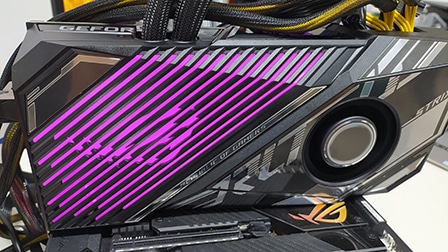Asus ROG Strix LC RTX 3080 Ti OC to the test: hybrid heatsink to keep Ampere at bay
After trying the GeForce RTX 3080 Ti in the Founders Edition version, finding a video card similar to the GeForce RTX 3090 in the gaming field, the first custom model has arrived in the editorial office and not just any one: we are talking about the Asus ROG Strix LC RTX 3080 Ti OC Edition (ROG-STRIX-LC-RTX3080TI-O12G-GAMING), strong of a system of hybrid cooling, which combines air with liquid.
This model, expected on the market starting from € 2,199 during the summer, is undoubtedly aimed at passionate about maximum performance, particular products and those who want something that certainly does not go unnoticed.
Dimensions aside (card: 29.3 x 13.3 x 5.2 cm; radiator with fan: 27.2 x 12.1 x 5.4 cm), the card boasts ARGB lighting along some strips on the cover plastic heatsink (complemented by an aluminum rear backplate), both via the ROG logo and above all the two fans on the radiator. Everything can be synchronized with other components thanks to Asus Aura Sync technology and manageable through the Armory Crate software.
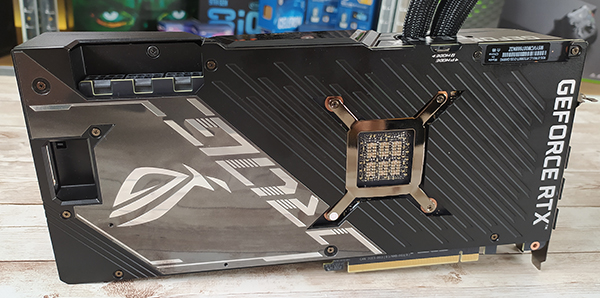

The other thing that immediately catches the eye is that for the power supply it is necessary to connect three PCIe 8-pin connectors, and this already gives you an indication of the TGP of the card that from 350W of the Founders Edition goes up to 400W. This not only gives room for an eventual overclock, but also to raise the factory frequencies. Not by chance the board has 18 phases for the GPU and another four dedicated to memory.
| GeForce RTX 3090 FE | GeForce RTX 3080 Ti FE | Asus ROG Strix LC RTX 3080 Ti OC Edition | |
|---|---|---|---|
| Architecture and GPU | Ampere GA102 | Ampere GA102 | Ampere GA102 |
| Productive process | Samsung 8nm | Samsung 8nm | Samsung 8nm |
| Die Size | 628 mm2 | 628 mm2 | 628 mm2 |
| Transistor | 28 billion | 28 billion | 28 billion |
| CUDA Core | 10496 | 10240 | 10240 |
| TMUs / ROPs | 328 / 112 | 320 / 112 | 320 / 112 |
| Tensor / RT Core | 328 / 82 | 320 / 80 | 320 / 80 |
| Base Clock | 1400 MHz | 1365 MHz | 1365 MHz |
| Boost Clock | 1700 MHz | 1665 MHz | 1830 MHz |
| Memory capacity | 24 GB GDDR6X | 12 GB GDDR6X | 12 GB GDDR6X |
| Memory bus | 384 bit | 384 bit | 384 bit |
| Memory speed | 19,5 Gbps | 19 Gbps | 19 Gbps |
| Bandwidth | 936 GB/s | 912 GB/s | 912 GB/s |
| TGP | 350W | 350W | 400W |
In fact, Asus’ proposal comes with Boost Clock rising to 1830 MHz from Founders Edition’s 1665 MHz. By installing the GPU Tweak II software and activating the OC profile, the boost value is pushed further to 1860 MHz.
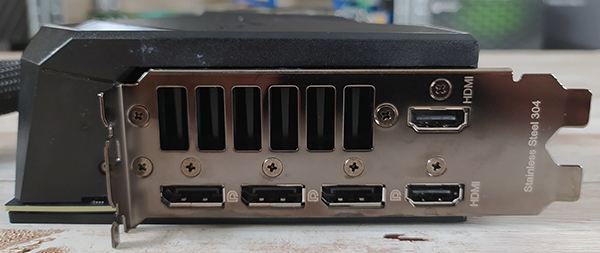
The rest of the features and frequencies are unchanged from the Founders Edition, there are just a few differences: the first is that the ROG Strix LC has an extra HDMI 2.1 output, so it has two, which add up to three DisplayPort 1.4a. Furthermore, the card boasts two FanConnect II PWM connectors that allow you to manage the fans of the houses based on the temperature of the GPU. Finally, to report the presence of one Dual BIOS switch that allows you to switch from Performance to Quiet profile.
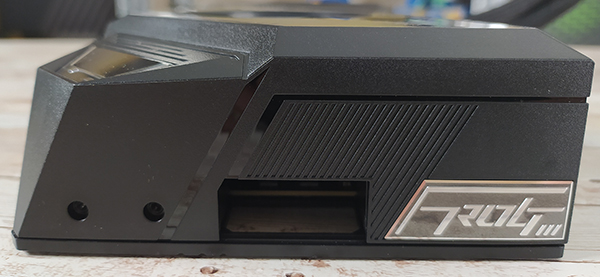
The cooling system
We wrote that the card has a hybrid cooling system, which combines active dissipation via a fan with a liquid system and its radiator. What does one do and what does the other do? There blower fan serves to capture fresh air from outside and allow it to flow onto the PCB of the board, so as to remove the heat from the power supply phases and other minor components.
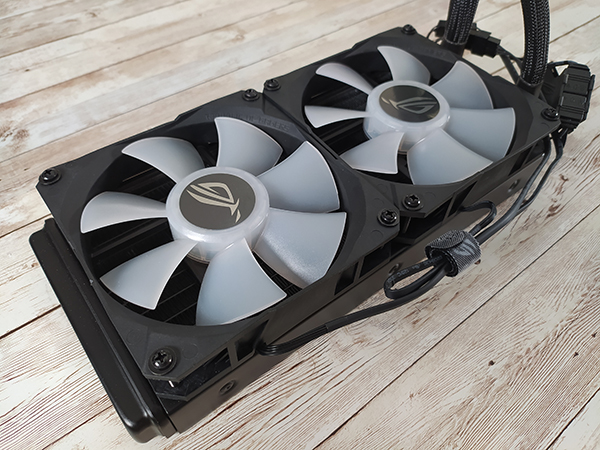
The system of liquid cooling therefore deals with cool the GPU and GDDR6X memory modules surrounding the graphics chip via a custom cold plate, connected to a pump from which they come out 600 mm long pipes which should guarantee installation even in very large EATX type houses. The 240 mm radiator see the presence of two 120mm fans optimized for high airflow and high static pressure.
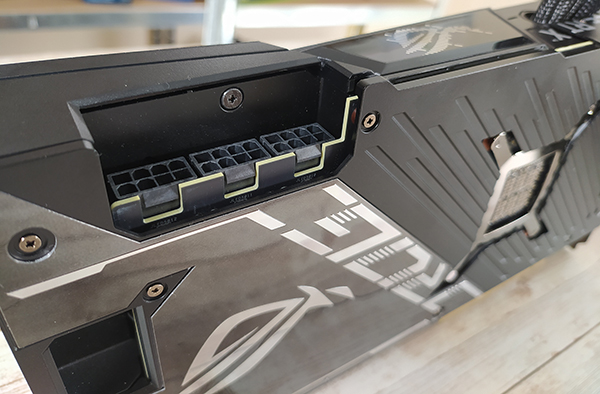
Test setup
We ran tests at the three most popular resolutions – 1920×1080, 2560×1440 and 3840×2160 -, with very high quality settings and the latest drivers, to put the video cards under load. To streamline the charts and focus on the focus of this article, we have removed some models from the other reviews. Below are the details of the test platform:
- Operating system: Italian Windows 10 Pro
- Processore: Intel Core i9-10900K
- Power supply: CoolerMaster Silent Pro Gold 1200 Watt
- Motherboard: ASUS ROG Maximus XII Hero WiFi
- Memoria: G.Skill Trident Z 2x8GB DDR4-4000 (17-17-17-37)
- SSD: Crucial P1 M.2 2280 1TB
Here are the cards used for the test:
- Nvidia GeForce RTX 3090 (Founders Edition)
- Asus ROG Strix LC RTX 3080 Ti OC Edition
- Nvidia GeForce RTX 3080 Ti (Founders Edition)
- Nvidia GeForce RTX 3080 (Founders Edition)
- Nvidia GeForce RTX 3070 (Founders Edition)
- Nvidia GeForce RTX 3060 Ti (Founders Edition)
- Nvidia GeForce RTX 2080 Ti (Founders Edition)
- Nvidia GeForce RTX 2080 SUPER (Founders Edition)
- Nvidia GeForce RTX 2080 (Founders Edition)
- Nvidia GeForce RTX 2070 SUPER (Founders Edition)
- Nvidia GeForce GTX 1080 Ti
- AMD Radeon RX 6900 XT (reference)
- AMD Radeon RX 6800 XT (reference)
- AMD Radeon RX 6800 (reference)
- AMD Radeon RX 6700 XT (reference)
Performance
As always, we try the custom cards with a smaller test suite, in order to check for any performance differences compared to the reference card – read: it makes no sense to do n thousand tests to characterize a product, especially after having tried the basic project. In the case of this Asus ROG Strix LC GeForce RTX 3080 Ti OC Edition we find 5-7% performance (depending on resolution) higher than Founders Edition in the tests carried out with the card set to the Gaming profile and BIOS Performance (the Quiet does not change the frequencies). These services are worth it, most of the time, gaming performance superior to the RTX 3090 Founders Edition.
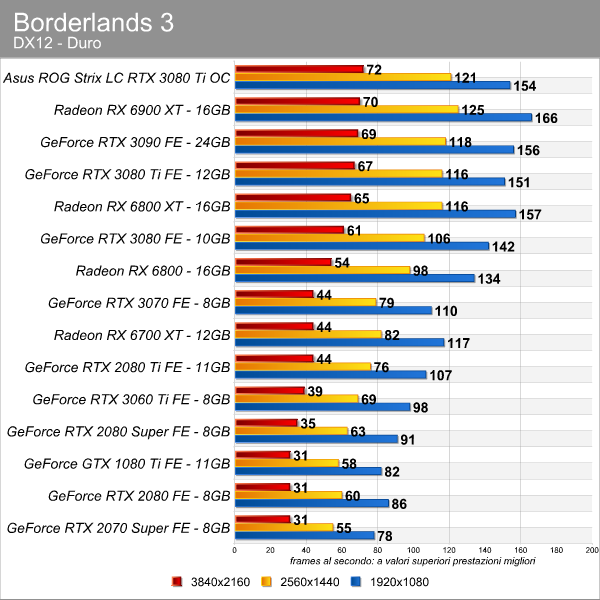
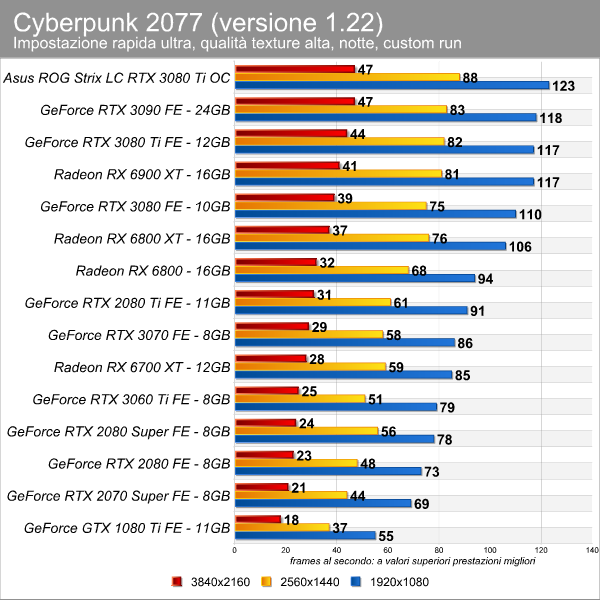
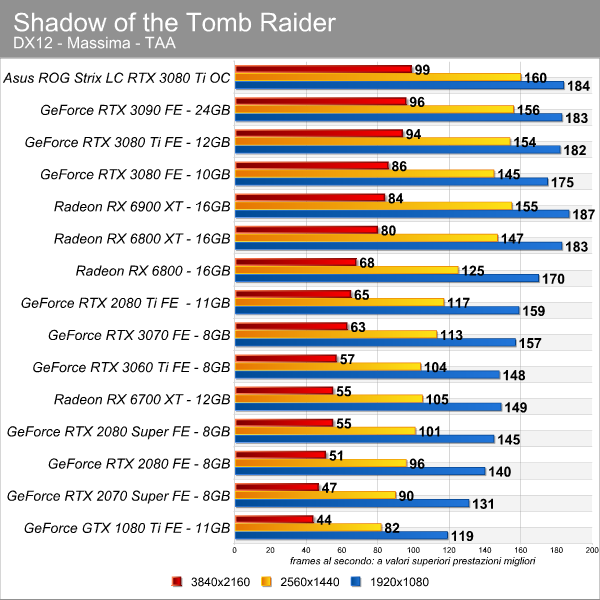
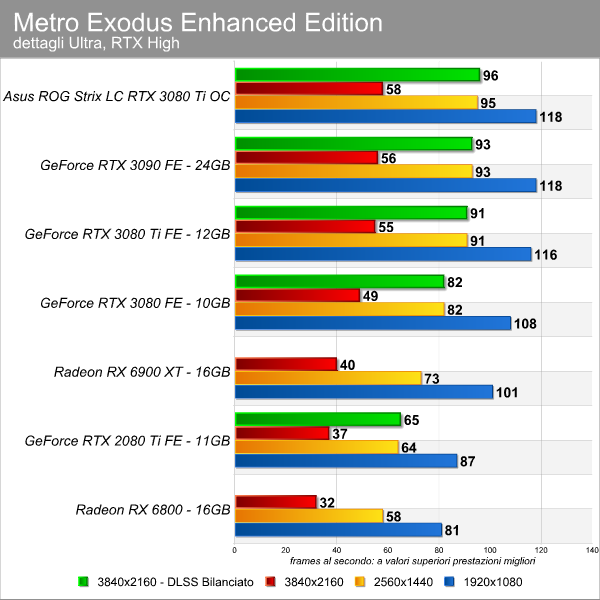
As a side note, a brief reference also to theoverclock of our sample. Carrying the Power Limit at 112%, or 450W, we managed to go up 160 MHz on the GPU (1525/1990 MHz), while the memory went up quietly by 1000 MHz: considering that the graphics chip was already quite overclocked from the factory, not bad!
Frequencies, consumption, temperatures and noise
The liquid cooling system, which takes care of the nearby GPU and memory chips, makes itself felt in terms of frequencies, as can be seen from the graph, and consequently on the performance as we have seen in the tests. If the GeForce RTX 3080 Ti Founders Edition throughout the test stands at an average clock of around 1640 MHz, Asus’ proposal goes to 1770 MHz. If we focus only on the sections under load, so where the frequencies are higher, the Founders settles at 1760 MHz, while the Asus ROG Strix LC RTX 3080 Ti OC Edition averages 1875 MHz.
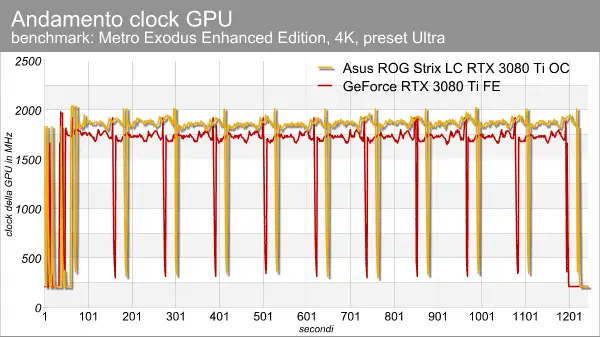
The plus of the card is undoubtedly the cooling system which allows you to get more performance from the GPU while keeping its temperature at bay at the same time. The graph is quite eloquent, with the GA102 GPU barely touching 54 ° C on Asus, compared to a Founders whose GPU reaches 77/78 ° C.
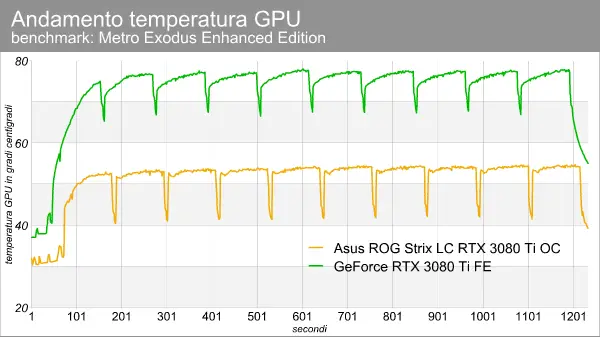



All roses and flowers then? No, because the higher performances are paid – and not only from a price point of view, but also in the bill. Asus card requires an additional 50W compared to the Founders Edition, arriving at the fateful 400W. So if a Founders RTX 3080 Ti requires at least a 750W power supply, this ROG Strix needs nothing less than a 850W of quality.
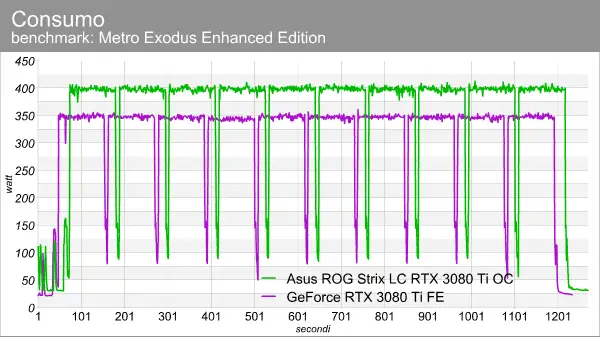
We come to the chapter of noise. We generally detect the noise at a distance of 10 cm, parallel to the fans of the video card, centrally, but in this case it is not the best way to characterize the noise of this solution, as we have a fan on the card that does not run more than 750 RPM, producing little noise, while the two fans on the liquid system radiator are heard much more. For this reason we have chosen not to produce a graph that would have appeared sterile, but to explain the findings in writing – the measurements are not carried out in an anechoic chamber, so they are not directly comparable between the different cards.
We can tell you that overall this ROG Strix LC RTX 3080 Ti OC Edition it is slightly noisier than a Founders, the two fans running on the radiator are heard – always detecting at about 10 cm, we recorded 52.5 dB with the sound level meter, while recording just in front of the fan we stop at about 45 dB. The Founders RTX 3080 Ti stops at 49 dB. In general, the ROG Strix seemed noisier to us, although a lot depends on your installation and the recirculation of the air inside the case.
Among other things, we have tried both with BIOS Performance and Quiet, but the difference under load is not so marked between the two profiles, we have not seen great acoustic changes and even the fans turn all in all only a little slower, without significant reflections on the temperatures. year. Maybe this is a problem with our sample? It may be, and in any case given the large temperature margin available, we suggest setting the Quiet profile to try to further contain the noise.
Conclusions
La Asus ROG Strix LC RTX 3080 Ti OC Edition it’s too much of everything: performance superior to the already excellent Founders and even the RTX 3090, not negligible dimensions, unconventional cooling system, high consumption and three 8-pin PCIe connectors, factory overclocking and an additional HDMI 2.1. There is not much more to add, is a card for enthusiasts who are looking for the best and who want to get it. It is clearly important to ensure that you have a proper case and power supply before purchasing this model.
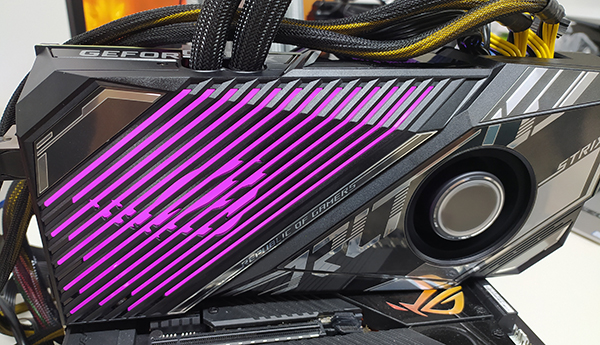
There is talk of a list price of around 2200 euros (against the 1200 euros of the RTX 3080 Ti FE indicated by Nvidia), but the technological production at the stake could even increase it, also because it is an “elitist” product and as such made in fewer numbers than a classic ROG Strix. Unfortunately this is the conclusion that we have to write for each video card review for several months now: apart from the strengths and weaknesses of a single proposal, it becomes complex and unrealistic to occur in a comparison with competing proposals and models from other realities. . We can’t wait for this moment to pass, but all the news so far suggests that there will still be a long time to wait.





